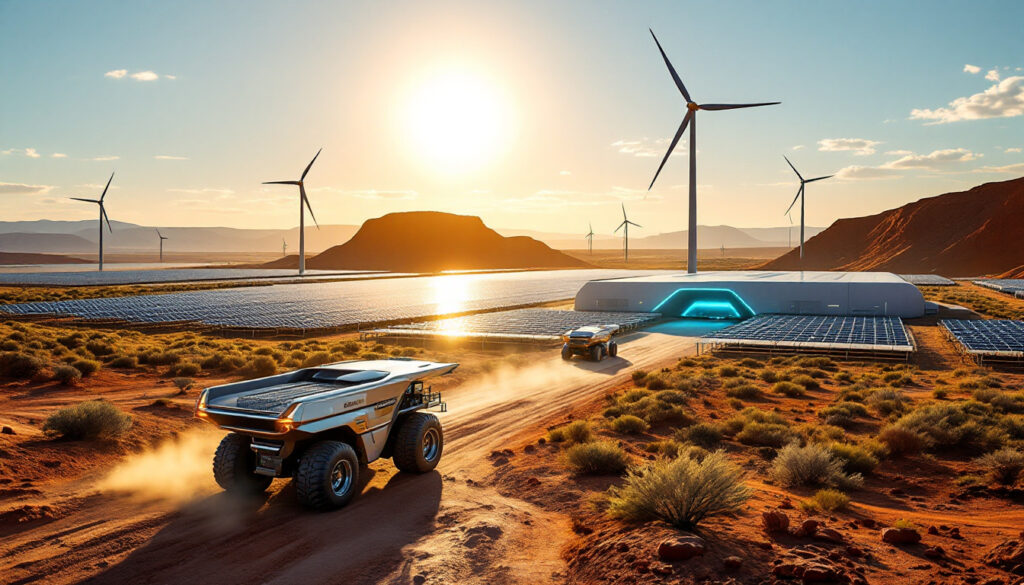The Future of Electrification: Powering Australia’s Mines
Australia’s mining sector is undergoing a transformative shift toward electrification, driven by environmental concerns, economic benefits, and technological advancements. This revolution is reshaping operations across the country’s vast mining landscape, from the lithium-rich fields of Western Australia to coal mines in Queensland and gold operations in Victoria. With mining’s pivotal role in the clean energy transition, electrification represents a critical evolution for the industry’s sustainability.
What is Driving Electrification in Australian Mining?
The Shift from Diesel to Electric Power
Australian mining operations are increasingly transitioning from diesel-powered equipment to electric alternatives to reduce emissions and operational costs. This shift represents one of the most significant technological transformations in the industry’s history, with implications stretching decades into the future.
According to industry data, diesel fuel can represent up to 40% of an underground mine’s energy costs. This substantial expense, combined with the logistical challenges of transporting fuel to remote locations, makes the economic case for electrification compelling. At Western Australia’s Greenbushes Lithium Operations, which produces 0.21 mtpa of lithium, the transition to electric vehicles has reduced fuel consumption by 35% since implementation began in 2021.
Major mining companies like BHP, Rio Tinto, and Fortescue have committed to net-zero emissions targets by 2050, accelerating transforming the mining industry through ESG initiatives. Rio Tinto’s sustainability report notes that “full electrification with renewables could eliminate 70% of Scope 1 emissions” across their operations, setting a benchmark for the industry.
Economic Benefits of Mine Electrification
Electric mining equipment can reduce operational costs by 10-20% compared to diesel equivalents, with some operations reporting even greater savings. The Mt Marion Lithium Project’s $46 million electrification investment has yielded a 23% reduction in operational expenses within the first year of implementation.
Maintenance costs for electric vehicles are typically 25-30% lower than for diesel equipment due to fewer moving parts, reduced complexity, and elimination of traditional engine maintenance requirements. Underground operations at Northern Star’s Jundee mine have documented 28% maintenance cost reductions after transitioning their light vehicle fleet to electric alternatives.
Battery technology advancements have improved equipment performance while reducing lifetime costs. Modern lithium-ion batteries designed specifically for mining applications can now withstand the extreme temperatures (often exceeding 50°C) common in Western Australian mining operations, with thermal management systems that extend battery life by up to 40%.
How Are Australian Mines Implementing Electrification?
Battery Electric Vehicles (BEVs) in Underground Mining
Underground mines are leading electrification efforts due to ventilation benefits and health considerations. The elimination of diesel exhaust in confined spaces creates an immediately safer working environment and substantially reduces ventilation requirements.
Electric load-haul-dump (LHD) machines and underground trucks eliminate diesel particulate matter (DPM), reducing air contamination from typical diesel levels of 50μg/m³ to less than 1μg/m³. This dramatic improvement not only enhances worker health but also extends equipment life due to cleaner operating conditions.
Ventilation requirements can be reduced by up to 50% with fully electric underground fleets, representing one of the largest operational cost savings from electrification. A typical underground gold mine can save $3-5 million annually in ventilation costs alone after full fleet electrification, according to a recent study by the CSIRO.
Surface Mining Electrification Technologies
Open-pit operations are adopting trolley-assist systems for haul trucks, reducing diesel consumption by up to 90% on uphill segments. These systems, which connect haul trucks to overhead electrical lines on ramps, leverage Australia’s increasingly renewable grid electricity while maintaining operational flexibility.
Autonomous electric haulage systems are being tested at several Australian mine sites, combining the benefits of electrification with reduced labor costs and improved safety. Rio Tinto’s AutoHaul® autonomous trains, though not battery-electric, demonstrate the potential of combining automation with digital integration in mining operations, having traveled over 7 million kilometers autonomously since implementation.
Electric conveyor systems are replacing diesel truck haulage for material movement, offering energy savings of up to 85% for comparable transport distances. The Pilgangoora Lithium Project, with production of 44.1kt lithium annually, utilizes an extensive electric conveyor network that has eliminated the need for 26 diesel haul trucks.
What Infrastructure Challenges Must Be Addressed?
Power Generation and Distribution Requirements
Remote mine sites require significant power infrastructure upgrades to support electrification. Rio Tinto’s 2024 figures indicate approximately $7.5 billion in grid upgrades needed across their Australian operations to support full electrification.
Renewable energy integration (solar, wind) is essential for achieving emissions reduction goals. Without renewable power sources, electrification simply shifts emissions from mine sites to power plants, undermining environmental benefits. Australia’s abundant solar resources make this integration particularly viable, with solar costs having fallen below diesel generation in all mining regions.
Microgrids combining renewables with battery storage are becoming standard for new mining projects. The Agnew Gold Mine achieved 80% renewable penetration in 2024, using a hybrid system of wind turbines, solar arrays, and battery storage, proving the viability of high renewable penetration even for energy-intensive operations.
Charging Infrastructure Development
Fast-charging systems capable of delivering 350kW+ are being deployed at strategic locations within mine sites. These high-power charging stations add approximately 25% to upfront costs but reduce lifetime operational expenses by 40% through improved equipment utilization.
Battery swap systems offer an alternative to charging for continuous operations, with some mines implementing automated battery exchange stations that can replace depleted batteries in under 10 minutes. This approach is particularly valuable for operations requiring 24/7 equipment availability.
Grid connection challenges in remote locations necessitate innovative power solutions, including localized renewable generation and storage. Some operations in Western Australia’s remote regions have pioneered virtual microgrids that intelligently balance load demands across multiple power sources, optimizing for both cost and reliability.
Which Australian Mining Companies Are Leading Electrification?
BHP’s Electrification Initiatives
BHP has committed to reducing operational emissions by 30% by 2030, backed by a $2 billion investment in electric haulage systems between 2022-2025. This commitment represents one of the largest capital allocations to electrification in the global mining sector.
The company is implementing electric vehicles across its Western Australian iron ore operations, with over 200 electric light vehicles already deployed and plans for electric heavy equipment to follow. These initiatives serve as pilot programs for broader implementation across BHP’s global operations.
BHP is partnering with equipment manufacturers to develop custom electric mining solutions tailored to Australia’s unique conditions. These partnerships include co-development arrangements with manufacturers like Komatsu and Caterpillar to ensure equipment meets the specific requirements of Australian mining conditions.
Rio Tinto’s Renewable Power Integration
Rio Tinto is investing $7.5 billion in decarbonization efforts through 2030, with electrification as a central component of their strategy. This investment covers both equipment transitions and the power infrastructure needed to support them.
The company is developing solar and battery storage projects to power operations across Western Australia and Queensland. Their 34MW solar farm at the Gudai-Darri iron ore mine provides up to 65% of the site’s electricity needs during peak solar production periods.
Rio Tinto is implementing autonomous electric haulage systems at multiple sites, combining the benefits of automation with electrification. Their early trials indicate productivity improvements of 15-20% over conventional manually operated diesel equipment.
Fortescue Metals Group’s Green Hydrogen Strategy
Fortescue is developing green hydrogen production to power mining equipment, with a focus on replacing diesel in heavy mobile equipment. CEO Elizabeth Gaines has stated that “Our decarbonization roadmap combines hydrogen and battery tech” to address different operational needs.
The company has set an industry-leading target of achieving carbon neutrality by 2030, twenty years ahead of most competitors. This aggressive timeline has accelerated innovation and implementation of electrification technologies across their operations.
Fortescue’s innovative green hydrogen strategy includes investing in electrified rail networks to transport ore from mines to ports, with plans for 2GW of renewable capacity to power these operations. Their approach encompasses both production facilities at mine sites and port infrastructure to support export opportunities.
What Role Do Renewable Energy Sources Play?
Solar Power Integration at Mine Sites
Australia’s abundant solar resources make photovoltaic systems ideal for powering remote operations. With over 300% growth in solar capacity at Australian mine sites since 2020, solar has become the fastest-growing energy source in the mining sector.
Large-scale solar installations can provide daytime power for processing facilities, which typically represent 60-70% of a mine’s energy consumption. Modern solar arrays with single-axis tracking can achieve capacity factors above 30% in Western Australia, making them economically competitive with diesel generation even without considering emissions benefits.
Solar capacity at Australian mine sites has grown by over 300% in the past five years, with several operations now operating solar farms exceeding 50MW. The economics of solar have improved dramatically, with levelized costs now below $40/MWh in optimal locations, compared to diesel generation costs of $180-220/MWh.
Wind Power Developments
Wind energy complements solar by providing power generation during nighttime hours. Combined solar-wind systems can achieve 70-80% renewable penetration without storage, rising to 95%+ when coupled with appropriate battery systems.
Several mining operations in Western Australia are developing wind farms to supplement power needs, particularly in coastal regions where wind resources are strongest. The Agnew Gold Mine’s 18MW wind farm, combined with solar and battery storage, demonstrates the viability of integrated renewable systems for mining operations.
Hybrid renewable systems offer the most reliable power generation profile, mitigating the variability inherent in individual renewable sources. Sophisticated control systems now enable these hybrid systems to provide power quality and reliability comparable to traditional grid connections.
Battery Storage Solutions
Grid-scale battery systems enable mines to store excess renewable energy for use during peak demand periods or when renewable generation is unavailable. These systems have become increasingly cost-effective, with prices falling by approximately 85% over the past decade.
Battery storage capacity at Australian mine sites is projected to increase tenfold by 2030, driven by both cost reductions and the need to balance variable renewable generation. Current installations range from 10MWh to over 100MWh, with larger systems becoming economically viable as battery costs continue to decline.
Virtual power plants (VPPs) allow for optimized energy management across operations, intelligently directing power where it’s most needed and reducing overall consumption. These systems can reduce peak demand charges by 15-25%, improving the economics of electrification initiatives.
How Will Electrification Impact Mining Productivity?
Operational Efficiency Improvements
Electric equipment offers higher torque and more precise control than diesel alternatives, translating to improved operational capabilities. Electric motors deliver maximum torque instantly, unlike diesel engines that require time to reach optimal RPM ranges, resulting in faster cycle times for loading and hauling operations.
Reduced maintenance downtime increases overall equipment availability by 15-20%, allowing for more productive hours per day. Electric vehicles typically require maintenance every 2,000-3,000 hours of operation, compared to 250-500 hours for comparable diesel equipment.
Digital integration enables better fleet management and predictive maintenance, with electric vehicles providing richer operational data that can be analyzed to optimize performance. This data-driven approach allows for continuous improvement in operational efficiency beyond the inherent benefits of electrification.
Worker Health and Safety Benefits
Elimination of diesel particulate matter improves air quality in underground environments, reducing respiratory health risks. Studies have shown that miners working in diesel-free environments have significantly lower rates of respiratory issues and reduced long-term health impacts.
Reduced noise levels from electric equipment enhance communication and reduce hearing damage risk. Electric vehicles typically operate at 65-75 dB compared to 85-95 dB for diesel equivalents, dramatically improving the working environment and reducing the need for hearing protection.
Lower heat generation from electric motors improves thermal conditions underground, reducing cooling requirements and enhancing worker comfort. This benefit is particularly valuable in deep underground mines where heat management is a significant challenge and expense.
Automation and Electrification Synergies
Electric vehicles are more compatible with autonomous operation systems due to their precise control characteristics and simplified drivetrains. The elimination of complex transmissions and hydraulic systems reduces potential failure points and simplifies automation implementation.
Precision control of electric drives enables more accurate autonomous navigation, improving safety and reducing wear on equipment. The instant torque response of electric motors allows automated systems to make more precise adjustments than is possible with the lag inherent in diesel engines.
Remote operation centers can manage multiple electrified autonomous vehicles simultaneously, reducing labor requirements while improving safety by removing operators from potentially hazardous environments. This integration of electrification and automation represents the future of electrification powering Australia’s mines, combining environmental benefits with enhanced productivity.
What Are the Latest Technological Innovations?
Next-Generation Battery Technologies
Solid-state batteries with higher energy density are being tested for mining applications, potentially offering 2-3 times the energy density of current lithium-ion batteries. These technologies could enable electric equipment to operate for longer periods between charges, further improving productivity.
Fast-charging battery chemistries reduce downtime between operational shifts, with some newer batteries capable of accepting 80% charge in under 30 minutes. These advancements directly address one of the primary operational concerns with battery-electric equipment.
Battery thermal management systems designed specifically for harsh mining environments allow electric equipment to operate reliably in extreme temperatures. These systems, which maintain optimal battery temperatures even when ambient conditions exceed 50°C, are crucial for Australian mining operations.
Hydrogen Fuel Cell Applications
Hydrogen fuel cells offer an alternative to battery power for heavy equipment, particularly for applications requiring extended operating ranges. Prototype hydrogen-powered haul trucks have demonstrated ranges up to 500km while carrying loads of 240 tonnes.
Pilot projects testing hydrogen-powered haul trucks are underway at several Australian mines, evaluating their performance against both diesel and battery-electric alternatives. Early results indicate that hydrogen offers a compelling middle ground, with faster refueling than batteries and zero emissions operation.
Green hydrogen production facilities are being developed near major mining regions, leveraging Australia’s clean energy revolution in mining to produce zero-emission fuel. These facilities will be crucial for scaling hydrogen use in mining, as transportation of hydrogen over long distances remains challenging.
Regenerative Braking Systems
Energy recovery during downhill haulage can reduce power consumption by up to 15%, capturing energy that would otherwise be lost as heat. This technology is particularly valuable in open-pit mining where heavy loads are frequently transported downhill.
Advanced regenerative systems capture and store energy that would otherwise be lost as heat, extending vehicle range and reducing overall energy consumption. Modern systems can recover up to 85% of the potential energy during downhill travel, significantly improving overall efficiency.
Integration with battery systems allows for optimized energy management, directing recovered energy either to immediate use or storage depending on operational needs. This intelligent energy management further enhances the benefits of electrification by maximizing the utility of every kilowatt-hour.
What Are the Environmental Benefits of Mine Electrification?
Carbon Emissions Reduction
Full electrification of a typical mine can reduce carbon emissions by 50-70% when powered by grid electricity, with greater reductions possible as Australia’s grid continues to incorporate more renewable energy. When powered directly by on-site renewables, these reductions can approach 100%.
When powered by renewables, mining operations can approach carbon neutrality, dramatically reducing the industry’s environmental footprint. Several Australian mines have already achieved carbon neutrality for specific operations through combinations of electrification and renewable power.
Scope 1 emissions from diesel combustion can be virtually eliminated through electrification, addressing a major component of mining’s environmental impact. For a typical large Australian mine consuming 20 million liters of diesel annually, this represents approximately 54,000 tonnes of CO2 equivalent.
Noise Pollution Reduction
Electric equipment operates at significantly lower noise levels than diesel equivalents, typically 10-15 dB quieter across equipment classes. This reduction represents a halving of perceived noise levels, dramatically improving the working environment.
Reduced noise improves relations with nearby communities and wildlife, minimizing one of the common objections to mining operations. Several mines near populated areas have reported improved community relations after transitioning to electric equipment.
Nighttime operations become more feasible with quieter equipment, allowing for more flexible scheduling without community impacts. This operational flexibility can improve overall mine productivity while reducing environmental conflicts.
Local Air Quality Improvements
Elimination of diesel exhaust improves air quality at mine sites and surrounding areas, reducing both visible pollution and harmful particulates. The health benefits extend beyond the mine workforce to surrounding communities, which often suffer from degraded air quality near traditional mining operations.
Reduced particulate matter benefits worker health and nearby communities, with measurable improvements in respiratory health. Studies of underground mines that have transitioned to electric equipment show dramatic reductions in respiratory symptoms among workers.
Lower heat generation from electric equipment reduces thermal pollution in the immediate environment, benefiting both workers and local ecosystems. This reduction in heat output also decreases cooling requirements, providing additional energy savings.
What Are the Financial Considerations for Electrification
Ready to Discover Mining Investment Opportunities Before the Market?
Don’t miss the next major ASX mineral discovery! Sign up for Discovery Alert’s 30-day free trial and receive instant, AI-powered notifications on significant discoveries, turning complex mineral data into actionable insights through the proprietary Discovery IQ model. Explore historic returns of major discoveries at https://discoveryalert.com.au/discoveries/ to see why timing is everything in mining investments.




